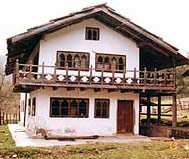 |
Bhutan Development |
 |
Bhutan Information |
|
|
 |
 |
| Farm road |
 |
 |
In
the early 80s the Gogona dairy farm in Wangduephodrang was regarded as
a successful model farm that could be replicated in other parts of the
country. But by the 90s the successful farm began to falter after squabbles
erupted amongst the Gogona community on ownership rights over pasture lands
and management of the dairy farm. The farm finally shut down in 1995, run
down and broke.
Now
almost a decade later, the local community want to start up the farm and
earn the additional income like it used to be in its heydays. |
|
"Gogona
lies on a high altitude and hardly anything grows there," said 54-year
old Tashi Dagay. Livestock is the main livelihood for the people of Gogona
which is a four-hour walk from Phobjikha valley.
 |
A community enterprise : the Gogona farmers
| The
community has already requested the dzongkhag administration for funds
to rehabilitate the farm and the Bhutan-Germany sustainable renewable natural
resources (RNR) development project (BG-SRDP) through the German technical
cooperation (GIZ) has committed about Nu 700,000 for equipment and renovating
the milk processing unit. |
|
The
Gogona farmers, meanwhile, have pooled about Nu 200,000 to buy 19 hybrid
cows from Bumthang to supply the milk for the processing unit which is
expected to become operational in about a year.
The
proceeds from the farm would be paid to the farmers depending on the amount
of money they invested in buying the cows. "The money we earn means better
food and clothes," said Kunzang Dorji who invested about Nu 20,000 in buying
the cows. "It will also be a great help when we conduct our annual lochoe."
The agriculture ministry also donated a hybrid breeding bull to the Gogona
community to improve and preserve the improved breed. The local bulls will
be castrated to protect the new stock from deterioration. The local cows
give about a litre of milk a day while the improved breeds gives about
four litres a day.
 |
The Gogona milk processing unit
| Reviving
the Gogona farm also means reviving the initial links of Swiss assistance
to livestock development in Bhutan which began with a milk processing unit
(MPU) at Maneting, near Phobjikha in 1968. Two years later, it was shifted
to Gogona. Under the Swiss, the Gogona dairy farm became a successful story
and a model farm for the rest of the country. The focus of the Swiss assistance
later shifted to Bumthang to replicate the success story in other regions
of the country. |
|
In 1975, the diary farm and the pastureland were handed
over to the local gomdhey on a loan of about Nu 100,000, which was to be
paid over a period of 10 years. The gomdhey sold the dairy farm and the
pastureland to four farmers in 1987 for about Nu 129,000.
However,
the right over the pastureland, which did not have any proper registration,
became the main bone of contention among the Gogona farmers. Misunderstandings
and non-cooperation among the farmers ultimately forced the MPU to shut
down. The Gogona community today has compromised on this issue and decided
that the pastureland would be distributed among its 33 households. One
extra acre would be allotted to each of the four farmers who bought the
farm from the gomdhey. The community has also decided to form a farmers
group to look after the daily operation of the dairy farm. The plan is
to start small initially with the products to be sold in Wangduephodrang
and other local markets. "Our ultimate goal would be to sell our processed
cheese to Thimphu and rest of the country and give competition to the well
known Bumthang cheese," said Kunzang Dorji.
With
the construction of a farm road link to Phobjikha, luck is once again shining
on Gogona.
| Contributed
by KUENSEL, Bhutan's National Newspaper |
 |
top
| Links |
 |
 |
 |
Externe Links |

|

|
GIZ
Gesellschaft für Internationale Zusammenarbeit
Rural
Development
|
Helvetas
Bhutan
|
|





